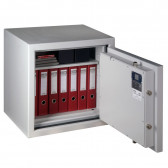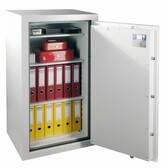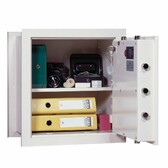When deciding on the purchase of a safe, it is worth taking into account the so-called security classes of safes. All this is done in order to match the product to individual needs and expectations and the size of the cash deposit we intend to store in the safe.
Burglary protection
A safe's anti-burglary protection class gives buyers information about the burglary resistance of a given safe. This means that the higher the safe's class, the higher the security level. Thus, items of greater value can be stored in it. And who determines what class a safe model has? Definitely not the manufacturer! The resistance of a safe is tested and certified by independent institutions, such as the German Association of Property Damage Insurers, which is recognised throughout Europe.
Various tests are carried out during these tests, using a variety of tools that can be used by burglars. The class of a safe is determined in accordance with standard EN 1143-1 for safes, safe room doors and safe rooms, or EN 1143-2 for deposit systems and drop safes. The security classes awarded are designated from 0 to XIII. A separate standard relates to safes of basic construction. The PN-EN 14450 standard distinguishes two security classes for them: S1 and S2.
Fire protection
However, the safety classes of safes are not only a question of burglary protection. It is also about the safety rating of safes with regard to fire protection. What does this mean? Will every safe providing fire protection have the same parameters? Well, no. Safes with the highest fire resistance will provide protection against fire, smoke, fire gases and fire extinguishing fluid for a longer period of time and under higher temperature conditions, even above 1,000 °C. The resistance of safes in this range is determined by taking into account the protection of the safe's contents against paper, i.e. for cash and documents, as well as analysing the fire resistance of data carriers. Safety classes for fireproof safes are specified by the PN-EN 1047-1 and PN-EN 15569 standards, while the PN-EN 14470-1 standard allows for the determination of a safety class for fireproof cabinets for flammable substances.
When deciding on a safe with a higher burglary and fire protection class, we incur a higher cost of purchase. At the same time, it is worth noting that a significant increase in the level of protection and security is a strong argument in negotiations with insurers. So by buying a better safe, we can count on lower property insurance premiums.
Deposit limits

But that's not all. While in the case of purchasing a safe for private use it is up to us to decide which model to choose, companies and institutions are bound by specific standards. These are set forth in the Ordinance of the Minister of Internal Affairs and Administration of 7th September 2010 on the requirements to be met for the protection of cash values stored and transported by businesses and other organisational units. The ordinance sets out the limits for cash stored or transported in premises and equipment.
Thus, no more than PLN 100,000 can be stored in a safe container or in an armoured cabinet, which is not protected by a burglary and assault signalling system. All because they meet lower security requirements than safes. On the other hand, in a safe, also unsecured by additional systems, the maximum value varies from around PLN 250,000 for class 0/D-0 (in accordance with PN-EN 1143-1 or PN-EN 1143-2) up to almost PLN 30,000,000 for safes of the highest security class, i.e. XIIIN-XIII.
It is hard not to notice, that no safe according to the regulation of the Minister of Internal Affairs and Administration guarantees such security that would enable storing money without limit. But in combination with additional solutions, such as a burglary and robbery signalling system, monitoring with event recording function and physical protection in the form of a 24-hour armed security formation, a VI/N-VI class safe can already store funds of virtually unlimited value! In other words, if you want to store funds of a certain amount in a safe, you can invest in a safe of a higher class, which will ensure protection in accordance with the limit of deposited values, or choose a safe of a lower class than required by the regulation, equipping the room with additional protection systems. Each of these solutions has its advantages and disadvantages. However, you will always find a safe that meets your needs in the Hartmann Tresore range. Certified safes meet customer expectations and always comply with the standards set by the relevant regulations.
Read also: Incompetent use of a safe. How to avoid costly mistakes?
Take care of your security and buy a certified safe with a high burglary resistance class






